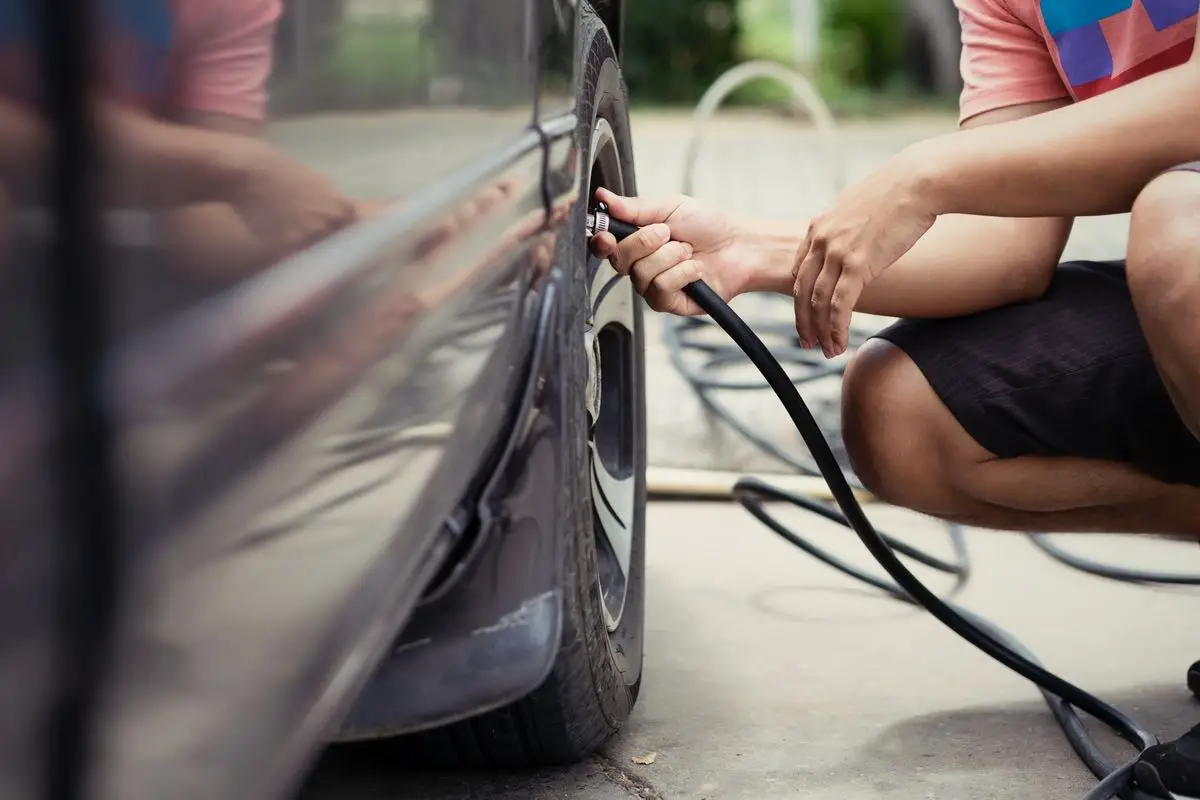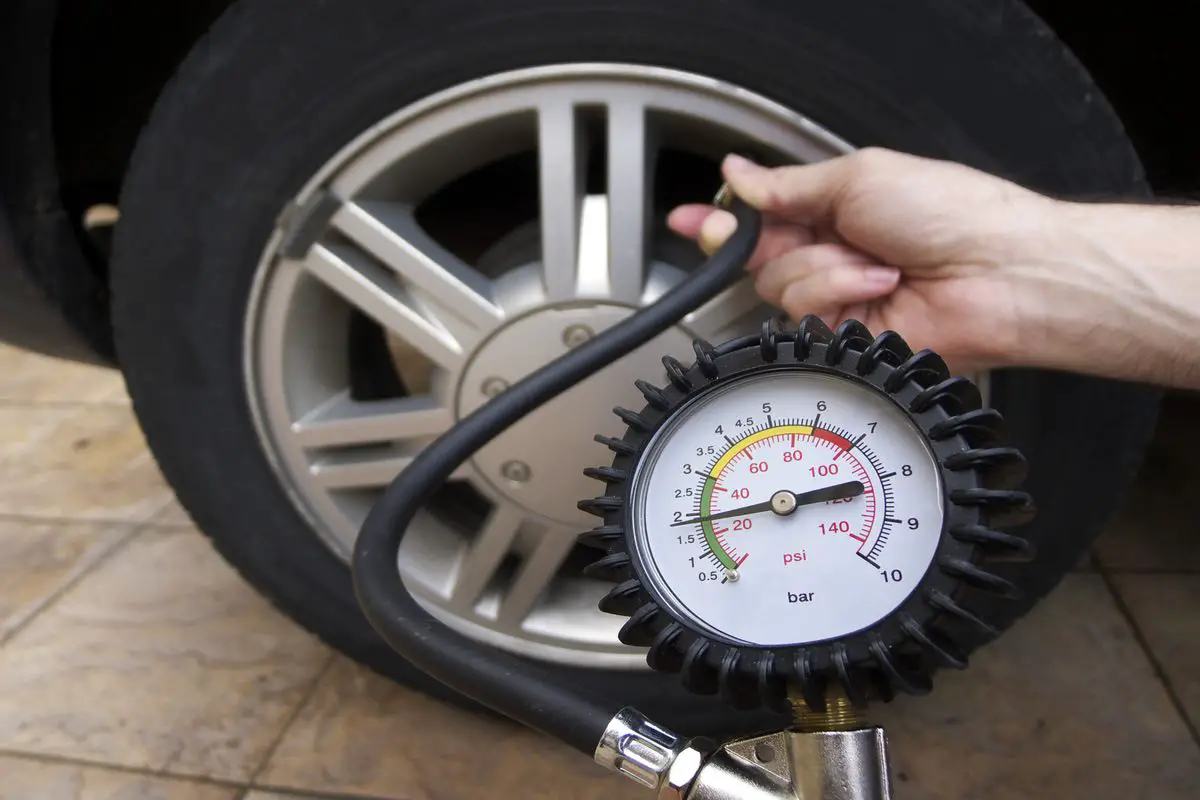35-inch tires can dramatically improve off-road performance. The wider tire with a longer circumference increases the tire’s contact with the road, leading to more traction and a better overall driving experience. But to enjoy the benefits of these tires, you need to get the tire pressure right.
The best tire pressure for 35-inch tires is 15-34 PSI (pounds per square inch), depending on the driving conditions. For everyday driving on conventional roads, 35-inch tires perform best at 28-34 PSI. On the other hand, offroading with these tires requires a lower pressure of 15-18 PSI.
The rest of this article will explore how to pressurize 35-inch tires in different scenarios to maximize their performance and that of your vehicle. I’ll also cover the one scenario you can deflate your 35s below 15 PSI, so be sure to give this post a thorough read.

Adjusting Tire Pressure for 35-Inch Tires to Various Driving Conditions
Different driving conditions require varying pressure levels within the 15-34 PSI range. Some situations require leaning to the higher end of that range, while others demand sticking to less than 20 PSI.
To help you maximize the performance of your 35s, let’s take a closer look at how to adjust their pressure in different applications.
Pressurizing 35-Inch Tires for Everyday Driving
For everyday driving on paved roads, keep the tire pressure of your 35-inch tires between 28 and 34 PSI. Sticking to this tire pressure range maximizes your tire’s performance, improves your driving experience, and prevents potential accidents.
Maintaining tire pressure between 28-34 PSI improves fuel efficiency on your daily commutes. It also improves handling by allowing your tires to provide sufficient grip regardless of the weather.
Maintaining the pressure range mentioned above also helps prevent overinflation. Tire pressure increases during drives due to increased temperature. Keeping the pressure between 28-34 PSI allows the tire enough room to adjust to air expansion, ensuring that pressure increase due to heat won’t inadvertently over-inflate the tire.
If you closely examine your tires, you’ll notice that the PSI indicated on the tire wall differs from the 28-34 PSI range. If you’re wondering why I’m not recommending the former, here’s the reason: the PSI figure on the tire wall is the maximum a tire can take, but it isn’t the recommended tire pressure for everyday driving. Inflating the tire to the max often leads to overinflation, which is something you’ll want to avoid for the following reasons:
- An overinflated 35-inch tire wears out the center of the tire faster as it has more contact with the road than the sides of the tire.
- With less tire surface on the road, you have less traction and may suffer compromised braking.
- Driving with overinflated tires increases the likelihood of a blowout.
Pressurizing 35-Inch Tires for Off-Roading
35-inch tires come alive during off-roading, providing the extra traction needed to overcome nature’s obstacles. They boost your vehicle’s grip by increasing the interaction between the tire and the ground.
35-inch tires work splendidly without modifications, but you can unlock extra performance from them by deflating the tire to between 15 and 18 PSI. Deflating the tires to this range improves offroad ride quality.
A tire inflated for driving on paved roads tends to bounce off surfaces rather than roll over them. That’s because the tensed-up sidewalls of a tire inflated for everyday use don’t allow it to it conform to obstacles like small rocks. By releasing some air from the tire, you allow the tire to conform to the off-road surface for a smoother ride.
Deflating a 35-inch tire also boosts their grip. The malleable sidewalls of a slightly deflated 35-inch tire press more of the tire’s surface onto the earth. As mentioned earlier, more ground contact leads to more grip.
It’s also worth noting that slightly deflated tires absorb impact better than tires inflated for everyday use. Off-roading terrain can be unforgiving, so having tires that absorb bumps can improve your wheeling experience.
Last but not least, you’re less likely to get stuck in mud, sand, or snow if you’ve deflated your 35-inch tires to between 15 and 18 PSI. The wider contact patch created by deflating the tire distributes the downward force over a larger area, reducing the chances of the tire digging into the surface. This way, the tire moves forward when you step on the gas instead of digging a hole.
Things to Keep in Mind When Inflating 35-inch Tires
Having covered the ideal pressure ranges for off-roading and everyday driving, let’s cover two key considerations to keep in mind when inflating your 35-inch tires for various driving conditions.
You’ll Need to Re-Inflate Your Tires Before Rejoining Paved Roads
Before you set out for off-roading, ensure you have the means to measure the tire pressure and to re-inflate your tires before rejoining paved roads. Tires deflated for off-roading are unsafe to use on paved roads.
Statistics show that under-inflated tires cause 40% of vehicle accidents. Underinflation causes the tire to overheat when rolling on the road, leading to increased tire wear and blowouts. A blowout, especially at high speed, can cause the driver to lose control of the vehicle.
Underinflation also affects braking (particularly during wet weather), as the vehicle tends to hydroplane. Hydroplaning occurs when the tire’s ability to disperse water is compromised. A vehicle hydroplanes when the wheels lose contact with the road and ride on the water’s surface.
To avoid all these issues, consider purchasing an air system to re-inflate your tires and a reliable tire pressure gauge to measure the PSI. An onboard air system takes 15 to 20 minutes to re-inflate your tires to the recommended range for paved-road conditions.
You Can Deflate Below 15 PSI When Using Beadlock Wheels
On most wheels, 15 PSI is the lowest you can go without dislodging the tire from the rim. That’s because these wheels use air pressure to hold the tire in place. Below a certain pressure, there isn’t enough force to hold the tire.
However, that’s not the case when you combine Beadlock wheels with your 35-inch tires.
Beadlock wheels lock the tire onto the rim, holding it in place regardless of the tire pressure. This means you can lower the pressure below 15 PSI without dislodging your tires to boost your vehicle’s off-road performance. You can air down all the way to 6 PSI or even lower, depending on how much of a boost you need.
Want to use 35-inch tires on your 20-inch rims? Read my complete guide to learn how. You’ll also learn tips for maintaining your 35-inch tires and find a list of top 35-inch tires for your 20-inch rims.

Conclusion
The best tire pressure for 35-inch wheels depends on the terrain ahead of you. If the vehicle is used almost exclusively on paved surfaces, 28-34 PSI will work perfectly.
If you plan to use the vehicle on rugged off-road terrain, you’re better off sticking to a lower pressure range of 15-18 PSI. When you have Beadlock wheels, you can deflate the tire to as low as 5 PSI.
Sources
- Driving Press: Recommended Tire Pressure – What Should My Tire Pressure be?
- State of Speed: Are 35-Inch Tires Right for Your Rig?
- Four Wheel Trends: Why it is Necessary to Deflate Tires in Soft Sand (Or Snow)
- DrivingLine: The Best Air Pressure for Off-Roading
- Motortrend: What are Beadlock Wheels?
- Car and Driver: Hydroplaning – What It Is & What To Do if Your Car Hydroplanes
- Eden Tyres & Servicing: The importance of having the correct tyre pressure
